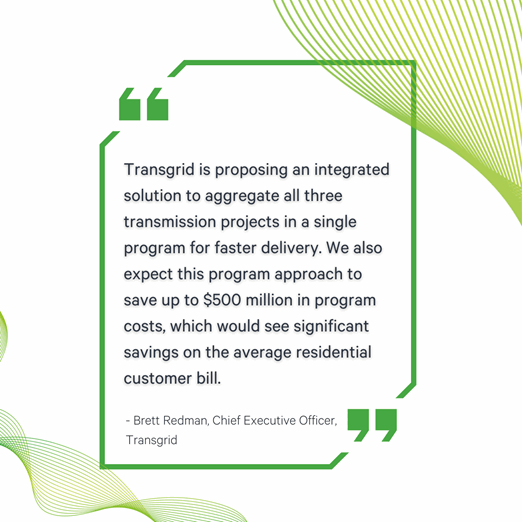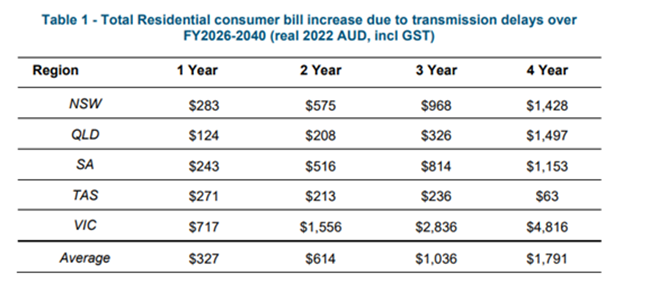“When it comes to energy transition, two years too soon is better than two years too late.” – Brett Redman, CEO of Transgrid
This is the topic I presented today at the Financial Review Energy & Climate Summit. In my keynote, I argued that the path to decarbonisation mapped out by the Federal Government is also the path to sustainable growth, job creation and energy security.
In my view, the Climate Change Bill is the modern equivalent of the Hawke Government’s 1983 decision to float the Australian dollar – a bold and profound economic reform that set the stage for decades of uninterrupted economic growth.
Today, the Government is driving forward a reform of equal, if not greater, impact. Australia has very ambitious plans, that will deliver profound environmental and economic benefits. There is no time to lose in executing them.
The energy industry must act quickly and decisively to get transition done
According to the Rewiring the Nation plan, meeting the Government’s 2030 target of cutting emissions by 43% will mean boosting renewable energy production to 82% of our electricity supply.
To achieve that 2030 target, we need to make the grid fit for renewables as quickly as possible.
We must build grid scale wind and solar renewables, from 16 GW now to 44 GW in 2030. Storage capacity, in the form of batteries, pumped hydro and virtual power plants, needs to increase from 2 GW now to 15 GW by 2030. [1]
But renewables and storage are only part of the equation. There is no transition without transmission. All the renewable energy in the world is useless unless we can get it to where it is needed, when it is needed.
The scale of the new transmission required is unprecedented
Just looking at Transgrid’s major projects alone, if we put all our new transmission cables together end-to-end, they would stretch from Sydney to London and three-quarters of the way back again.
AEMO’s 2022 Integrated System Plan (ISP) responds to this need. It predicts dramatic changes to our energy mix, leading to – as Minister Bowen describes it – an ‘ISP on steroids’.
But is it fast enough? I believe we need to move even faster than the ISP is currently projecting.
Why? Because Transgrid’s analysis suggests that technical, commercial and social pressures will lead to coal generators retiring even more rapidly than currently forecast – especially as competition from renewable generation intensifies.
The transition isn’t coming – it’s here
Two weeks ago, NSW hit a new 20-year minimum demand record of 4253 MW. On the same day we curtailed 4.4GWh of renewable energy due to capacity constraints on the transmission network.
We must establish new renewable resources before coal generators withdraw. Otherwise we risk supply shortfalls. We must ensure sufficient supply to meet demand at all times.
This is something we can all agree on. And the states are certainly on board. With the strong support of state energy ministers, Transgrid has recently completed three significant transmission projects:
- Powering Sydney’s Future – creating a reliable and affordable energy supply to support Sydney’s economy.
- The Queensland-NSW Interconnector – boosting interstate transmission capacity and increasing power flow on existing lines.
- Victoria to NSW Interconnector upgrade – unlocking access to renewable energy generation.
We are proud that we delivered all three of these projects on time, on-budget and with a community focus. But we believe the next tranche of crucial ISP projects could and should be completed faster than the current schedule and cheaper than the current approach.
Transgrid is currently developing three new major projects of critical significance. Currently scoped as separate projects – they are:
- HumeLink – increasing the transfer capacity between southern NSW and the major load centres of Sydney, Newcastle and Wollongong
- Victoria NSW Interconnect – expanding interconnector capacity between Victoria and NSW
- Energy Connect – 900km of transmission infrastructure connecting power grids across three states
All three projects are critical to implementing the recently released ISP. To ensure energy security, we believe they need to be delivered earlier than is currently planned. In fact, Transgrid is proposing an integrated solution – constructing all three projects in a single program. We are confident this approach can deliver the projects faster than the timelines set out in the ISP.
In addition, by delivering efficiencies and through the benefits of scale, we expect this program approach to save up to $500 million in program costs, which would see significant savings on the average residential customer bill.

We are at the point where we must accelerate
Because too early is better than too late. Two years too early is a little bit of extra cost and a bit awkward. Two years too late starts risking things like the market failure of a couple of months ago.
Early is important if we are going lock in skilled labour and critical parts and components – and book in delivery slots. The better organised we are, the better our outcomes, prices, timing and delivery.
According to Endgame Economics, a one-year delay in transmission investment would increase a residential consumer’s bill by an average of $327 over the period 2026-40.[2] A four-year delay would increase the same bills by an average of $1,791. (See Table 1)
For every day that the optimal development path of the ISP is delayed, residential consumer bills go up by around $1 to $2 in 2022 real value.
The cost to consumers of the June market intervention was $1bn. Early delivery is a valuable insurance against incurring more costs like this.

I understand the challenges involved in what I am suggesting.
Unfortunately, delivering big infrastructure projects brings some unavoidable disruption to landowners and their local communities.
Currently, critical transmission networks are being delayed by understandable concerns that customers don’t pay more than necessary, by funding constraints caused by allowable rates of return out of step with commercial reality and by calls for putting cables underground. We are working with governments and regulators to resolve these issues and strike a balance between minimising disruption and keeping the lights on.
Together, we can and must find a way forward. The consequences of delaying transmission are inconceivable. We cannot risk a situation where – because we have not been bold enough – homes, hospitals and industries risk being without power.
We must prioritise security and affordability of supply while working closely with local communities to make sure they are treated fairly and with respect.
In 40 years’, when we look back on Australia’s energy transition, it will be seen in the same light as our flexible exchange rate – an essential reform leading to strong economic prosperity.
This is the lens through which to consider our next decisions around transmission.
We must work together to accelerate transmission projects, using new approaches and innovative frameworks – so Australia can reach its net-zero goals while assuring future energy security.
[1] AEMO, 2022 Integrated System Plan
[2] Report-Modelling-Electricity-bill-impact-due-to-transmission-delay_2022-06-07.pdf (nexaadvisory.com.au)
